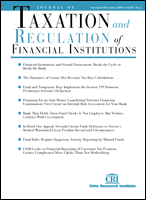Complete Issue
Author: Houman B. Shadab.
Source: Volume 24, Number 03, January/February 2011 , pp.1-54(54)

< previous article |return to table of contents
Abstract:
Fallout from the financial crisis is far from behind us. As we continue into the new year there is almost no aspect of our financial system that has not been permanently changed-- or given a new prominence--by responsive changes to market practices or legislative or regulatory enactments. This issue of the Journal of Taxation and Regulation Financial Institutions illustrates the widespread impact of the financial crisis through several articles covering disparate topics that, of necessity, are motivated in substantial part by the recent market turmoil and/or policymakers response to it. In our first article, Sean R. Wilke reviews and analyzes a relative newcomer to the investment fund universe—the actively managed exchanged-traded fund (ETF). Although ETFs historically have been associated with passive investment vehicles that are a lower-cost alternative to actively managed mutual funds, financial innovation has recently led to the combining of features of both traditional ETFs and mutual funds into the actively managed ETF product. As Mr. Wilke notes, the rise of actively managed ETFs is in part a response to investor demand for the “best of all worlds” in a single fund product: active management and diversification along with transparency and ease of transferability. His article details the contractual structure of ETFs, applicable U.S. and European securities and tax laws, and in particular the legal framework created by the E.U.’s Undertakings for Collective Investment in Transferable Securities. The next article, by Ira G. Bogner and Adam W. Scoll, focuses on a very different type of collective investment fund: employee pension benefit plans. Mssrs. Bogner and Scoll focus on three U.S. Department of Labor (DOL) rulemakings under the Employee Retirement Security Act of 1974 relating to such plans, as well as provisions from the Dodd-Frank Act relating to swap plan arrangements. The DOL regulations seek to increase legal protections afforded to plans by requiring certain service providers to reveal compensation and conflict-of-interest information, requiring plan administrators to disclose plan and investment-related information, and changing the parameters as to when an investment adviser to a plan will be considered a fiduciary. The Dodd-Frank Act’s wide ranging regulation of over-the-counter swaps includes specific provisions applicable to ERISA plans and their swap counterparties, and the authors’ analysis of these provisions rounds out their discussion. Next up, Ernest E. Badway and Matthew S. Adams present a comprehensive primer on the primary forum for dispute resolution in the financial services industry, namely, alternative dispute resolution as governed by the Federal Arbitration Act, the laws of individual states, and the rules of various self-regulatory organizations. Special attention is paid to the framework provided by FINRA Alternative Dispute Resolution, the largest forum for securities dispute resolution in the U.S. Mssrs. Badway and Adams detail both the securities arbitration and mediation processes in a highly informative account. They also review the common types of arbitration claims brought by retail customers as well as from within the industry. This issue concludes with Roy Sedore’s “U.S. International” column, in which he analyzes the implications and ambiguities of recently proposed regulations from the Internal Revenue Service covering three different types of entities: series limited liability companies, protected cell companies, and a foreign series or protected cell company conducting an insurance business.Keywords:
Affiliations:
1: Journal Editor, New York Law School.